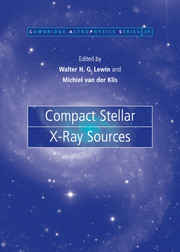Book contents
- Frontmatter
- Contents
- List of contributors
- Preface
- 1 Accreting neutron stars and black holes: a decade of discoveries
- 2 Rapid X-ray variability
- 3 New views of thermonuclear bursts
- 4 Black hole binaries
- 5 Optical, ultraviolet and infrared observations of X-ray binaries
- 6 Fast X-ray transients and X-ray flashes
- 7 Isolated neutron stars
- 8 Globular cluster X-ray sources
- 9 Jets from X-ray binaries
- 10 X-rays from cataclysmic variables
- 11 Super-soft sources
- 12 Compact steller X-ray sources in normal galaxies
- 13 Accretion in compact binaries
- 14 Soft gamma repeaters and anomalous X-ray pulsars: magnetar candidates
- 15 Cosmic gamma-ray bursts, their afterglows, and their host galaxies
- 16 Formation and evolution of compact stellar X-ray sources
- Author index
- Subject index
1 - Accreting neutron stars and black holes: a decade of discoveries
Published online by Cambridge University Press: 01 September 2009
- Frontmatter
- Contents
- List of contributors
- Preface
- 1 Accreting neutron stars and black holes: a decade of discoveries
- 2 Rapid X-ray variability
- 3 New views of thermonuclear bursts
- 4 Black hole binaries
- 5 Optical, ultraviolet and infrared observations of X-ray binaries
- 6 Fast X-ray transients and X-ray flashes
- 7 Isolated neutron stars
- 8 Globular cluster X-ray sources
- 9 Jets from X-ray binaries
- 10 X-rays from cataclysmic variables
- 11 Super-soft sources
- 12 Compact steller X-ray sources in normal galaxies
- 13 Accretion in compact binaries
- 14 Soft gamma repeaters and anomalous X-ray pulsars: magnetar candidates
- 15 Cosmic gamma-ray bursts, their afterglows, and their host galaxies
- 16 Formation and evolution of compact stellar X-ray sources
- Author index
- Subject index
Summary
Introduction
Since their discovery in 1962 (Giacconi et al. 1962), accreting compact objects in the Galaxy have offered unique insights into the astrophysics of the end stages of stellar evolution and the physics of matter at extreme physical conditions. During the first three decades of exploration, new phenomena were discovered and understood, such as the periodic pulsations in the X-ray lightcurve of spinning neutron stars (Giacconi et al. 1971) and the thermonuclear flashes on neutron-star surfaces that are detected as powerful X-ray bursts (see, e.g., Grindlay et al. 1976; Chapter 3). Moreover, the masses of the compact objects were measured in a number of systems, providing the strongest evidence for the existence of black holes in the Universe (McClintock & Remillard 1986; Chapter 4).
During the past ten years, the launch of X-ray telescopes with unprecedented capabilities, such as RXTE, BeppoSAX, the Chandra X-ray Observatory, and XMM-Newton opened new windows onto the properties of accreting compact objects. Examples include the rapid variability phenomena that occur at the dynamical timescales just outside the neutron-star surfaces and the black-hole horizons (van der Klis et al. 1996; Strohmayer et al. 1996; Chapters 2 and 4) as well as atomic lines that have been red- and blue-shifted by general relativistic effects in the vicinities of compact objects (Cottam et al. 2001; Miller et al. 2002b).
- Type
- Chapter
- Information
- Compact Stellar X-ray Sources , pp. 1 - 38Publisher: Cambridge University PressPrint publication year: 2006
- 16
- Cited by

